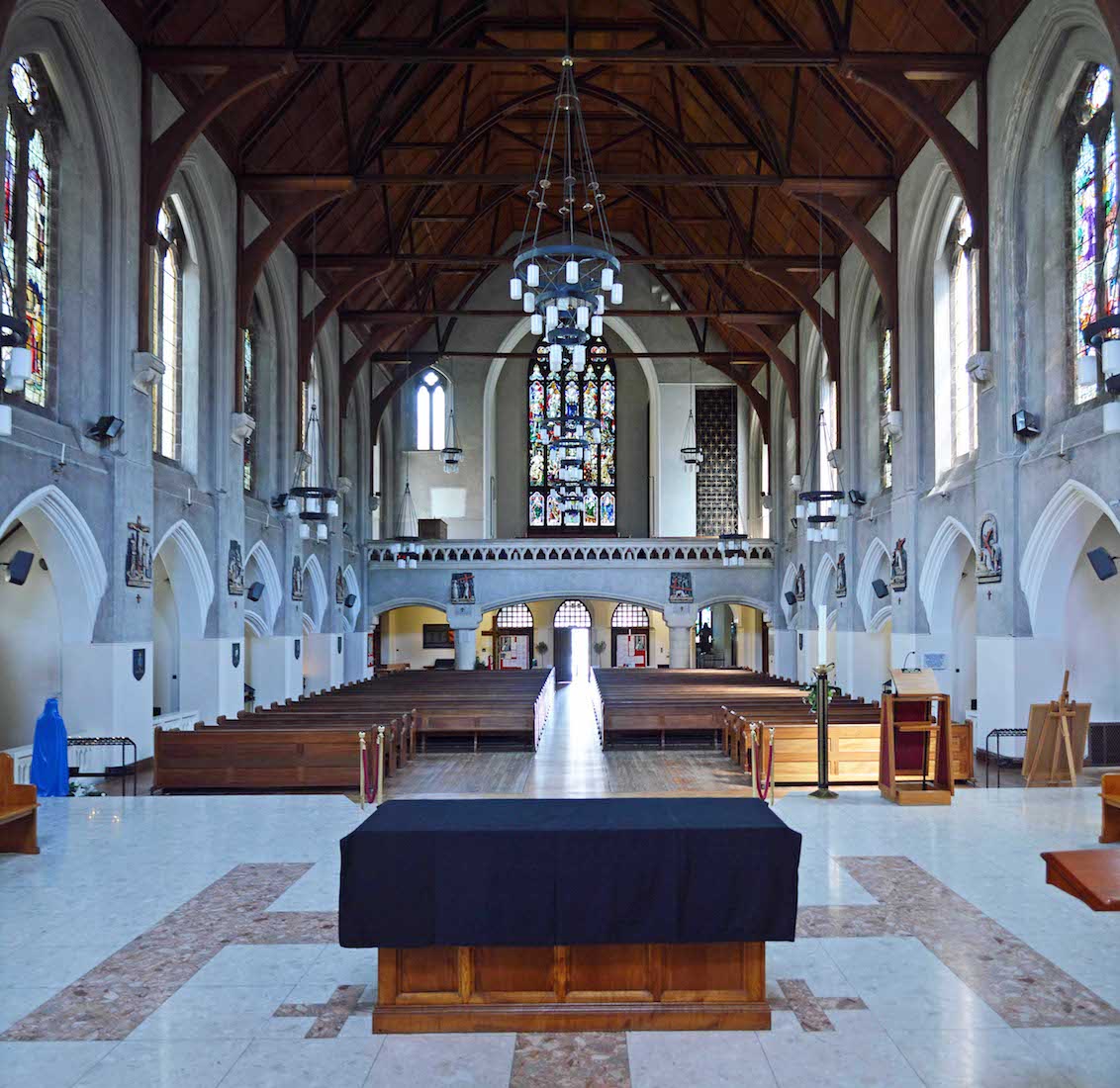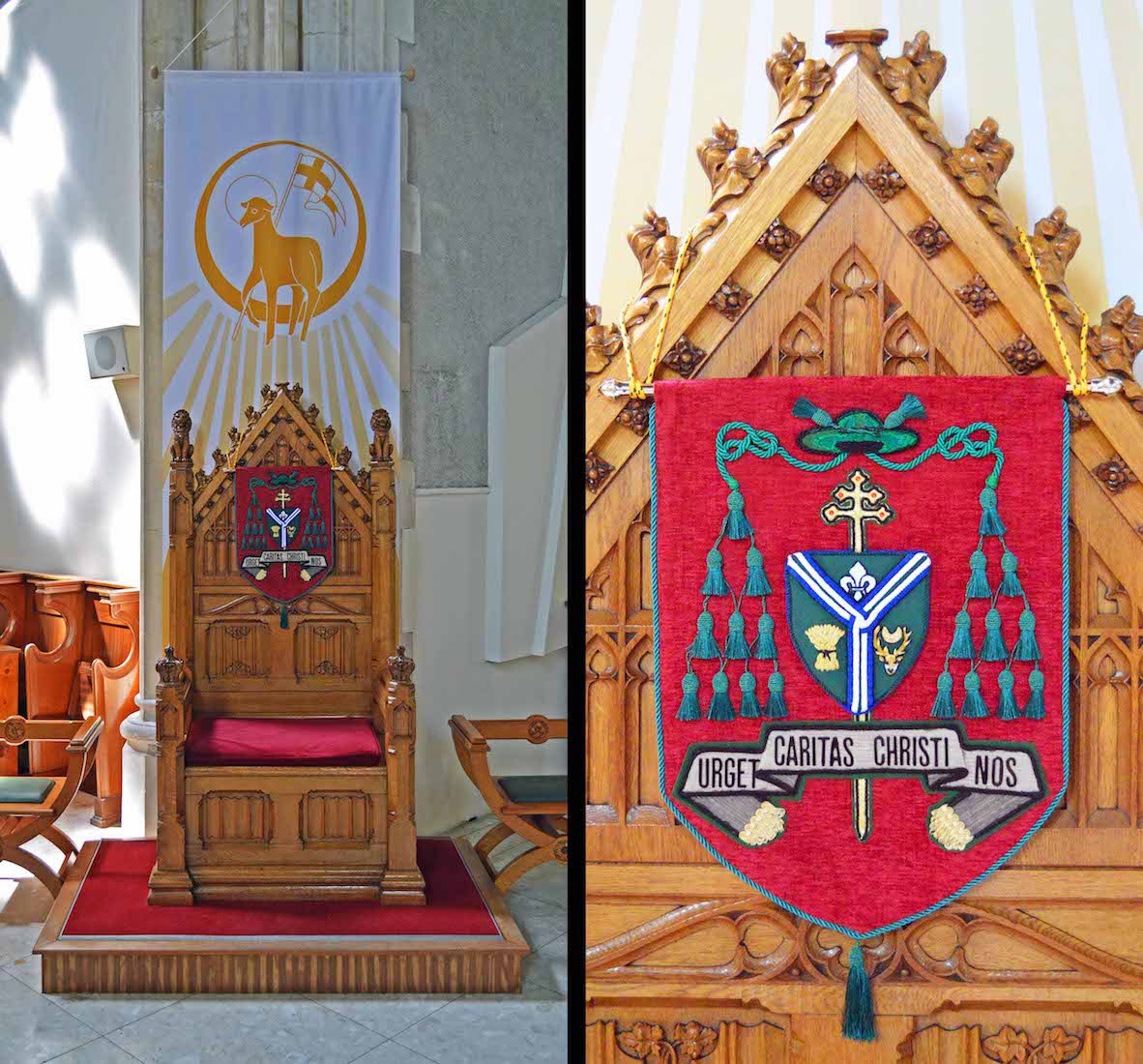41. THE VIRGIN MARY

At right is a statue of the Virgin Mary, Mother of Jesus. She is wearing blue, indicating purity. In front of her is a bunch of white lilies, again a symbol of purity and virginity. Mary is seen here holding an orb – a symbol of her Son’s lordship over the earth.
42. ALTAR

At the centre of the chancel is an imposing altar, as we have seen, placed at the centre of a Jerusalem cross. This is a focal point for Cathedral worship, with the Eucharist being administered from here. This altar has an elaborately carved front panel.
43. LAST SUPPER
The carved front panel shows Jesus and the disciples at the Last Supper. This is a very skilfully carved depiction. The last meal that Jesus shared with his disciples before the Crucifixion is described in all four canonical Gospels. This meal later became known as the Last Supper.
44. EVENING ALTAR VIEW
If we stand behind the altar, we can look right down the length of the Cathedral. This has a different appearance in the pale evening light. There are two plain windows and two stained glass windows at the sides of the chancel which we have already noted.
45. RISEN CHRIST BANNERS
Finally we come to the side East walls of the chancel and the narrower sanctuary itself. Each side wall has a decorative triangular feature with a central banner. The banners appear to be identical and show the Risen Christ ascending through the clouds. There is a larger banner showing the Risen Christ at the Northern corner of chancel and sanctuary.
46. CATHEDRA
At the opposite corner stands the cathedra, or Bishop‘s throne. The term ‘cathedra‘ comes from the Latin, meaning seat or throne. It is the cathedra which signifies the Bishop’s special association with this church, thereby giving it the name Cathedral. In this view we notice a set of sedilia in the sanctuary at left, and the South triangular feature at right. Beyond that in the ‘transept’ is a type of dresser..
47. CATHEDRA DETAILS
Behind the cathedra is a banner with an image of the Lamb and flag. The image is the Agnus Dei, the Lamb of God, although the English flag is more of a mystery! On the back of the cathedra is the coat of arms of the Cardiff Catholic Diocese with text, ‘We urge the love of Christ’.
48. SIDE CABINET
In the South side transept is this carved dresser with an enclosed aumbry – presumably not used, noting the absence of the expected light.
49. SANCTUARY WINDOWS
We move into the sanctuary itself. Here there are four stained glass windows, two on each side, which picture various events in the life of St David. Saint David c. 500 – c. 589 was a Welsh bishop of Mynyw (now St Davids) during the 6th century. He was a native of Wales, and is the patron saint of Wales. A relatively large amount of information is known about his life. He is traditionally believed to be the son of Saint Non and the grandson of Ceredig ap Cunedda, king of Ceredigion.
50. TABERNACLE
The small sanctuary is very simply furnished with a pedestal bearing a tabernacle, a stand of flowers on either side, and a niche behind with a small sanctuary crucifix. The tabernacle contains the Elements of the Eucharist.
51. SANCTUARY CROSS
We complete our tour of this Cathedral at the sanctuary Crucifix – a reminder that the death and resurrection of Christ are the events which form the basis of Christianity.
CONCLUSION
I hope you have enjoyed visiting St David’s Catholic Cathedral, Cardiff with me.
I am happy to receive constructive comments or corrections concerning this website. The best websites are the ones which have no errors! I am grateful to my wife Margie who has proof-read these pages.
However, due to the relative lack of online material and printed matter about this Cathedral, I suspect there will be some future alterations and additions.
The link for the Cathedral website is:
https://cardiffcathedral.org.uk/
The photographs which appear on this site can also be found in higher resolution at:
https://www.flickr.com/photos/paulscottinfo/albums/
Paul Scott Site created 07 / 2019










